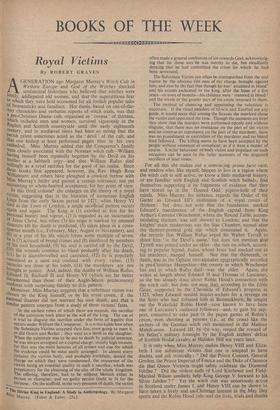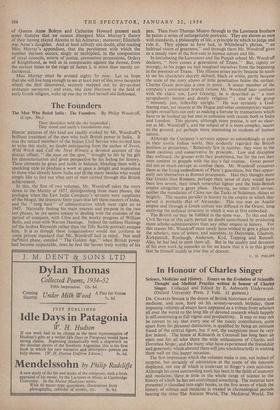BOOKS OF THE WEEK
• .
Royal Victims By ROBERT GRAVES GENERATION ago Margaret Murray's Witch Cult in Western Europe and God of the Witvhes shocked sentimental historians who believed that witches were lonely, addlepated old women, and that the superstitious fear In which they were held accounted for all foolish popular tales of broomsticks and familiars. Her thesis, based on out-of-the- Way chronicles and verbatim reports of witch trials, was that a pre-Christian Dianic cult, organised in ' covens ' of thirteen, which included men and women, survived vigorously in the English and Scottish countryside until the early eighteenth century, and in medieval times had been so strong that the Parish priest sometimes acted as the ' devil ' of the cult, and that one bishop at least performed pagan rites in his own cathedral. Miss Murray added that the Conqueror's family Were closely associated with the Norman witch cult—William having himself been reputedly begotten by the Devil on his Mother at a Sabbath orgy—and that William Rufus died Willingly as a royal sacrifice for the good of his realm. Since these books first appeared, however, the Rev. Hugh Ross Williamson and others have ploughed a crooked furrow with Miss Murray's heifer and gained a certain tolerance, not yet amounting to whole-hearted acceptance, for her point of view. In this third volume* she enlarges on the theory of a royal victim, suggesting that in the histories of numerous English kings from the early Saxon period to 1471, when Henry VI died in the Town of London, a single sacrificial pattern occurs again and again. The King is (I) extolled at first for his Personal beauty and vigour, (2) is regarded as an incarnation °C Jesus Christ, but when (3) his reign is marked by unusual disasters (4) his death is predicted, (5) takes place in a cross- quarter month (i.e., February, May, August or November), and ,(6) in a year of his life which forms some multiple of seven, he is (7) accused of brutal crimes and (8) murdered by members 9f his own household, (9) his soul is carried off by the Devil, 10) the wounds continue to bleed profusely after his death, (l1) he is disembowelled and castrated, (12) he is popularly canonised as a saint and credited with every virtue, (13) miracles are done at his tomb, (14) the murderers are not brought to justice. And, indeed, the deaths of William Rufus, Edward II, Richard II and Henry VI (which are far better documented than those of their Anglo-Saxon predecessors) conform with surprising fidelity to this pattern. Moreover, Miss Murray suggests that a substitute victim was chosen by the King himself, or by his royal coven, if the national disaster did not warrant his own death, and that a similar pattern emerges from a study of these victims' fates.
In the earliest times of which there are records, the sacrifice often made a general confession of sin towards God, acknowledg- ing that for those sins he was worthy to die, but steadfastly denying that he had committed the crime for which he had been sentenced.
The Substitute Victim can often be distinguished from the real traitor by the obvious fals:ness of the charge brought against him, and also by the fact that though he was' attainted in blood' and his estates escheated to the king, after the lapse of a few years—or even of months—his children were ' restored in blood ' and the whole or the greater part of his estate returned to them.
The method of choosing and appointing the substitute is uncertain. If the ritual murders of Oswin and Eanfred are any guide, it would seem that among the Saxons the overlord chose the victim and appo:ntcd the time. Though the accounts are brief they show that the murders were performed openly and without disguise, that there was no resistance on the part of the victim and no remorse or repentance on the part of the murderer, there was no punishment or execration of the murderer and no blOod feud followed. The killing seems to have been accepted by the people without comment or complaint, as if it were a matter of course. S.milar behaviour of both victim and populace on such occasions can be seen in the fuller accounts of the disguised sacrifices of later times.
For all this she makes out a convincing prima facie case, and readers who, like myself. happen to live in a region where the witch cult is still active,-or know a little mediaeval history, or are familiar with English and Scottish witch ballads, find themselves supporting it by fragments of evidence that they have stored up in the ' Deuced Odd' pigeon-hole of their minds. Miss Murray, for instance, regards the Order of the Garter as Edward III'S institution of a royal coven of thirteen : but does not note that the foundation marked Edward's transference of the English capital from King Arthur's Camelot (Winchester, where the Round Table, accom- modating thirteen, was still shown) to London; and that the knights' main rendezvous was the Star Chamber, named after the thirteen-pointed gold star which dominated it. Again, she records that William Rufus urged Sir Walter Tyrrell to shoot him in the Devil's name,' but does not mention Ahat Tyrrell was posted under an elder—the tree on which, accord- ing to popular legend, Judas, whom Jesus had marked out as his murderer, hanged himself. Nor that the thirteenth, or death, tree in the Ogham tree-alphabet epigraphically recorded in pre-Christian Hampshire—the county in which Winchester lies and in which Rufus died--was the elder. Again, she writes at length about Edward II and Thomas of Lancaster, as she has already done'about Robin Hood's connection with the witch cult; but does not note that, according to the Little Geste, supported by the Chronicle of Edward's progress in 1323, when Edward needed master-archers for a revenge on the Scots who had defeated him at Bannockburn, he sought out the Wakefield Robin Hood— now known to have been one of Lancaster's outlawed followers--and, to gain his sup- port, consented to take part in the pagan games of Robin's coven, even shooting at pennies (i.e., at the cross) like the archers of the German witch cult mentioned in the Malleus Maleficarum. Edward III, by the way, reaped the reward of his father's military foresight by the English archers' defeat of Scottish feudal cavalry at Halidon Hill ten years later.
It is only when Miss Murray makes Henry VIII and Eliza- beth I use substitute victims that one is tempted to have doubts, and ask ironically : " Did the Prince Consort, General Gordon, the. Prince Imperial of France and the Duke of Clarence die that Queen, Victoria might safely celebrate the Diamond Jubilee ? Did the violent ends of Lord Kitchener and Field- Marshal Wilson similarly help King George V forward to his Silver Jubilee '? " Yet the witch cult was notoriously active in Scotland under James I, and Henry VIII can be shown to have taken a lively and un-Christian interest in the May Day sports and the Robin Hood cult; and the lives, trials and deaths of Queens Anne Boleyn and Catherine Howard present such queer features that we cannot disregard Miss Murray's theory of their having played Alcestis to his Admetus ; moreover, Elizabeth was Anne's daughter. And at least nobody can doubt, after reading Miss Murray's appendices, that the persistence with which the number thirteen occurs, singly or multiplied, in the composition of royal councils, courts of justice, coronation processions, Orders of Knighthood, as well as in conspiracies against the throne, from the earliest times to the reign of James I, is more than merely co- incidental.
Miss Murray must be around eighty by now. Let us hope that she will live long enough to see at least part of this terra incognita which she first discovered, securely mapped out by dry-as-dust ordnance surveyors ; and even, like Jane Harrison in the field of early Greek religion, wake up one day to find herself old-fashioned.



































 Previous page
Previous page